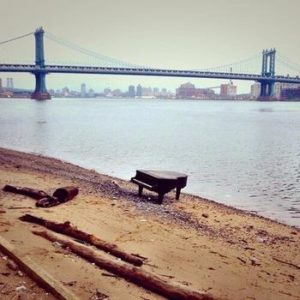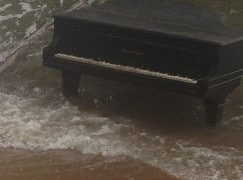Steinway issues memorandum on flood-damaged pianos
mainBasically, the advice is buy a new one.

From Steinway & Sons:
Due to the unfortunate events and widespread flooding caused recently by Hurricane Harvey, we are posting our information regarding pianos that may have been damaged by flood waters. This information is relevant not just to pianos that were potentially damaged in this storm, but also to any flood situation involving your piano. Our heartfelt wishes for recovery go out to everyone who was affected by this terrible disaster.
REGISTRY OF DAMAGED AND DESTROYED PIANOS
We strongly recommend that you receive a letter from STEINWAY that provides the replacement value of your existing STEINWAY, Boston, or Essex piano. We offer this service to provide you with official documentation that may be useful in filing insurance claims or updating your current inventory documentation. If your piano has been destroyed, we would also like for you to contact us so that we can include this in our historical records for STEINWAY, Boston, and Essex pianos.
To obtain this letter or to contact us concerning your piano, please complete the form below. Please include the serial number (and model, if known). This information is necessary to determine the replacement value of your piano. Be sure to include your address for our return mail to you.
USEFUL INFORMATION CONCERNING FLOOD DAMAGED PIANOS
Piano Exposure to Water/Moisture
Exposure to or immersion in water can indeed be very damaging to a piano. Even the exposure only to extreme changes in temperature and humidity for a few days in unoccupied homes and buildings can create extended instability in an instrument that will require numerous tunings and regulation of the action to ensure proper performance.
Immersion of the Piano above the Case
Pianos that have been sitting in water that has risen to the level of the case or higher will in all likelihood be damaged too badly to be restored and must be replaced. Direct exposure of the case, soundboard, strings, and action assembly to water can commonly cause major glue failure of integral structural components.
The rim and keybed of the piano are perhaps the most critical elements in determining the severity of present and future damage. The glued laminations of the rim can be weakened by exposure to water and cannot effectively be repaired. Damage by water also will not necessarily manifest itself immediately. It may take six to nine months for the effects of glue failure and wood deterioration to become fully evident.
Even the solidity of a STEINWAY rim cannot overcome the natural forces that occur when wood is exposed directly to water. The strings in a piano can have a combined tension of over twenty tons. Failure of the glue in the rim laminations severely compromises the ability of the rim to sustain these forces.
Shallow Water Exposure
Pianos that have been sitting in a few inches of water, but where the water has not reached the level of the case, are not necessarily ruined beyond repair. However, the effects of moisture still take their toll on all of the piano components and even these pianos would best be replaced rather than repaired. Constant exposure to excessive humidity can cause rust to form on the many metal parts in a piano including strings, tuning pins, hardware, action parts, and the cast iron plate that supports the tons of tension exerted by the strings. The soundboard will also be exposed to harsh climatic conditions that will cause severe expansion and contraction of the spruce that comprises the soundboard. The glue joints and wood grain of the soundboard can be permanently damaged by this movement and thus require replacement of the soundboard. The only way to ensure proper long-term integrity of the instrument is replacement of these parts.
The finish of the piano can also damaged by excessive moisture. The wood under the finish will move in the same manner as the soundboard described above. Cracking, checking, and other finish defects will likely result from this and thus necessitate refinishing of all furniture components of the instrument.
The Presence of Mold and Other Bacteria
Mold and other bacteria can form in the many areas of the piano that cannot effectively be reached for cleaning and eradication. The Center for Disease Control (CDC) states on their website: After natural disasters such as hurricanes, tornadoes, and floods, excess moisture and standing water contribute to the growth of mold in homes and other buildings. When returning to a home that has been flooded, be aware that mold may be present and may be a health risk for your family. It is recommended that the piano owner consult a specialist in mold and bacteria removal prior to undertaking any repairs or restoration of the piano.
For further information concerning mold and other health concerns, visit the CDC website at www.cdc.gov/disasters/hurricanes/pdf/moldprotection.pdf






Comments